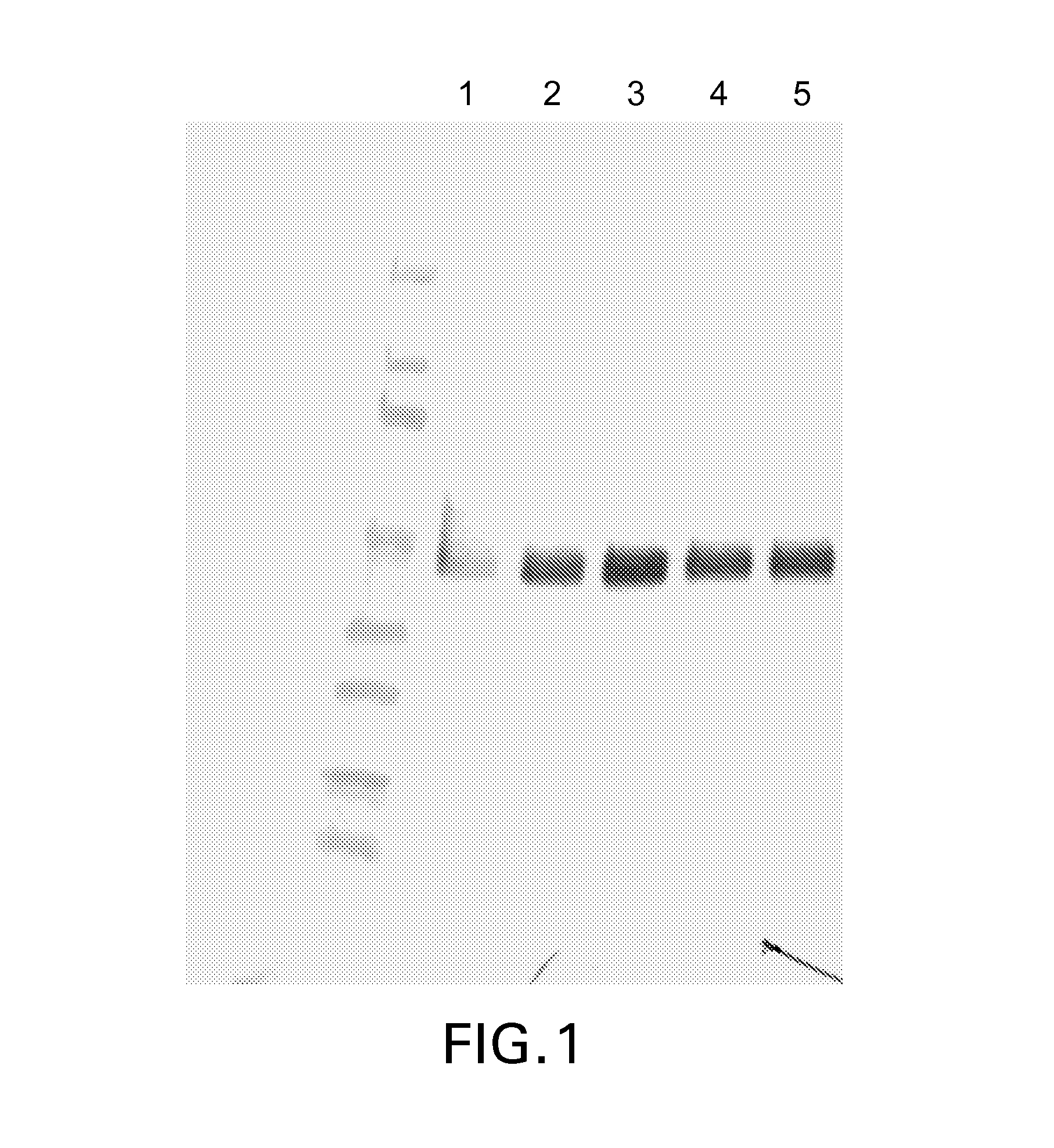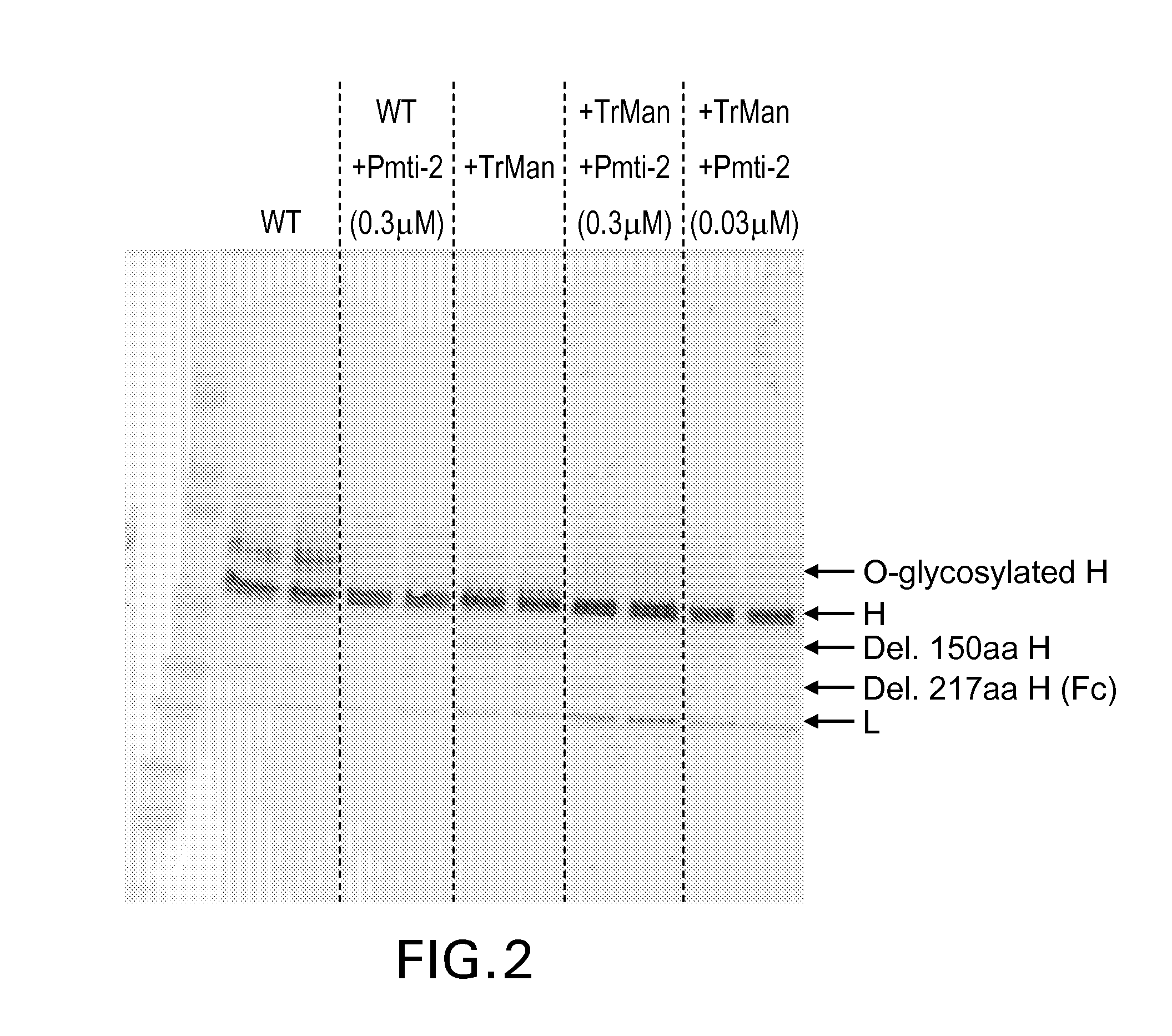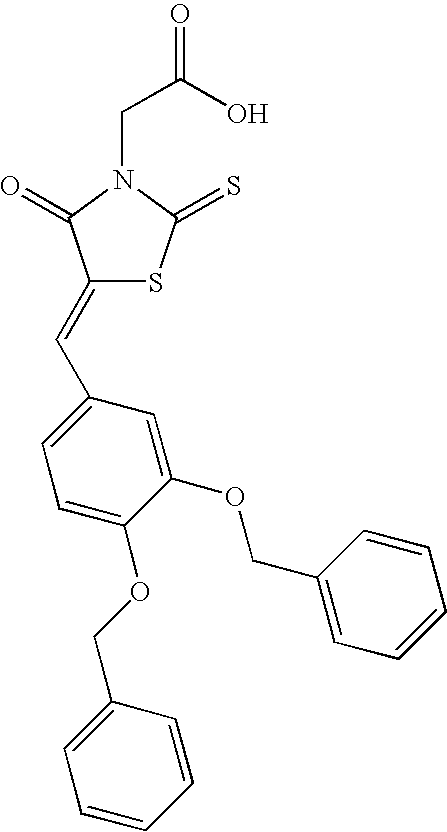Production of glycoproteins with reduced O-glycosylation
a technology of oglycosylation and glycoprotein, which is applied in the field of protein production, can solve the problems of requiring both ongoing viral containment and significant time to generate stable cell lines, and reducing the amount of o-linked glycosylation of the recombinant protein or glycoprotein
- Summary
- Abstract
- Description
- Claims
- Application Information
AI Technical Summary
Benefits of technology
Problems solved by technology
Method used
Image
Examples
example 1
[0072]This example provides method for preparing various Pmt inhibitors. Unless otherwise stipulated all materials were obtained from Sigma-Aldrich Chemical Co. (St. Louis, Mo.) and used as received. The 1H NMR spectra of all intermediates and final products were in accord with published data.
[0073]Preparation of Pmti-1, (5-[[3,4-bis(phenylmethoxy)phenyl]methylene]-4-oxo-2-thioxo-3-thiazolidineacetic Acid), is as follows.
[0074]
[0075]The procedure was adapted from Orchard et al in U.S. Pat. No. 7,105,554. A solution of rhodanine-3-acetic acid (1 g, 5.20 mmol, 1 eq.), 3,4-dibenzyloxybenzaldehyde (2.04 g, 6.25 mmol, 1.2 eq.), and sodium acetate (1.3 g, 15.6 mmol, 3 eq.) in acetic acid (30 mL) is heated to reflux, and stirred overnight. As the reaction mixture is cooled to room temperature, the product is precipitated and filtered and washed with acetic acid, then petroleum ether. The residue is dissolved in hot DMSO, filtered, and precipitated by addition of water. Upon cooling, the pr...
example 2
[0084]This example shows that Pichia pastoris transformed with an expression vector encoding the Kringle 1-3 marker glycoprotein and treated with Pmt inhibitors produced a glycoprotein having reduced O-glycosylation.
[0085]Plasmid DNA encoding a His-tagged reporter glycoprotein consisting of human plasminogen domains K1, K2, and K3 (Kringle 1-3 protein) under the control of the Pichia pastoris alcohol oxidase 1 (AOX1) promoter was transformed into wild-type Pichia pastoris to produce strain yJC53. The Kringle reporter protein consisting of domains K1, K2, K3, and K4 has been discussed in Duman et al. Biotechnol. Appl. Biochem. (1998), v.28, p. 39-45 and only domain K3 in Choi et al., 2003, Proc. Natl. Acad. Sci. U.S.A. 100(9): 5022-5027. The amino acid sequence of the Kringle 1-3 protein used in the Example is SECKTGNGKNYRGTMSKTKNGITCQKWSSTSPHRPRFSPATHPSEGLEENYCRNPDNDPQGPWCYTTDPE KRYDYCDILECEEECMHCSGENYDGKISKTMSGLECQAWDSQSPHAHGYIPSKFPNKNLKKNYCRNPDRE LRPWCFTTDPNKRWELCDIPRCTTPPPSSGPTYQ...
example 3
[0093]In this example, yeast cells transformed with DNA encoding the T. reesei α-mannosidase results in production of proteins with reduced O-glycosylation and that the O-glycosylation was further reduced when the cells were also incubated in the presence of a Pmt inhibitor.
[0094]The H+L chains of an anti-Her2 monoclonal antibody were expressed in Pichia pastoris strains GS115 (WT) and GS115 that was genetically engineered to co-expressed T. reesei α-mannosidase (+Trman). GS115 is available from Invitrogen (Carlsbad, Calif.) and, with the exception of a HIS4 mutation to enable his4 selection, has an essentially wild type phenotype. The H+L chains were expressed as two separate genes from plasmid pJC284, which was derived from Invitrogen plasmid pAO815.
[0095]The H+L genes were generated using anti-Her2 antibody sequences obtained from GenBank. The GenBank accession number for the L chain is 1N8Z_A and the GenBank accession number for the H chain variable region plus CH1 domain is 1N8...
PUM
| Property | Measurement | Unit |
|---|---|---|
| temperature | aaaaa | aaaaa |
| flow rate | aaaaa | aaaaa |
| temperature | aaaaa | aaaaa |
Abstract
Description
Claims
Application Information
 Login to View More
Login to View More - R&D
- Intellectual Property
- Life Sciences
- Materials
- Tech Scout
- Unparalleled Data Quality
- Higher Quality Content
- 60% Fewer Hallucinations
Browse by: Latest US Patents, China's latest patents, Technical Efficacy Thesaurus, Application Domain, Technology Topic, Popular Technical Reports.
© 2025 PatSnap. All rights reserved.Legal|Privacy policy|Modern Slavery Act Transparency Statement|Sitemap|About US| Contact US: help@patsnap.com



